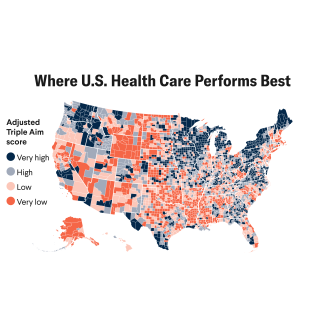Though we remain very much in the midst of the pandemic—with projections of a rough winter to come—it's important to think about what comes after COVID-19. Specifically, how can decision-makers support programs to help people move past this once-in-a-lifetime disruptive event? And how have mental health services and barriers to care changed as a result of COVID-19? Is there anything to learn from the adjustments forced upon us by the pandemic? This is the second in a two-part series on COVID-19 and its mental health burden. Read part one here.
When COVID-19 is finally behind us, its impact will likely continue to be felt
That said, the "end" of the pandemic won't be soon, however much we may wish it would be. Even if one or more vaccines appear in the next few months, the logistics of production and distribution mean that we aren't looking at the U.S. population being fully vaccinated until the summer of 2021. That's only in the United States, of course. The timetable is potentially much longer in low- and middle-income countries without ready access to vaccine production. And when COVID-19 is finally behind us, the impact of the pandemic will likely continue to be felt long after the virus itself is gone.

For example, U.S. gross domestic product (GDP) fell nearly 10 percent in the second quarter of 2020, "the equivalent of a 32.9 percent annual rate of decline," according to the New York Times. While GDP is a broad, aggregate means of measuring economic activity, a decline in GDP means, generally, that less money is changing hands in an economy. This can translate to more widespread hardship and tighter belts. America's COVID-19-tightened belt has meant exactly that: despite government aid, households and businesses across the United States continue to declare bankruptcy.
U.S. gross domestic product (GDP) fell nearly 10 percent in the second quarter of 2020 according to the New York Times
Between economic hardship and the steady procession of challenges—from adjusting daily routines to wearing face masks and practicing social distancing, to simply reading the news—that is living through the pandemic, it will take time to heal the various shocks 2020 has brought with it, which could mean prolonged worry for millions. But the issue of COVID-19 and mental health has not gone unaddressed. A recent study in the journal Psychiatric Services offers strategies for mitigating COVID-19's impact on mental health. And a Lancet Psychiatry paper explores ways the practice of mental health care should change. The Psychiatric Services authors recommend a number of policy priorities. They include focusing on suicide and substance abuse prevention, boosting the use of telehealth (and providing internet access to patients), supporting workers who lose their health insurance, and facilitating social service connections.

"The immediate need is to expand suicide and domestic violence response systems, to expand prevention services, [and] to shore up providers facing financial distress in the near term," they conclude in their paper.
The COVID-19 pandemic could be an opportunity to improve mental health care for everyone
The team behind the Lancet Psychiatry paper, meanwhile, note that the pandemic "could provide an opportunity to improve the scale and cost-effectiveness of different mental health interventions." Specifically, the attention COVID-19 has brought to mental health, via articles like the one you're now reading, could increase "mental health literacy" and opportunities for self-care. While effective intervention strategies exist for mental disorders, the number of people receiving what would be considered minimally adequate treatment strategies remains very low—even in high-income settings. Additionally, people who do receive treatment often do so years after the onset of their disorders. Therefore, broadening access to mental health in a way that doesn't lessen the quality of care, "could even turn the COVID-19 pandemic into an opportunity to improve mental health care for everyone," the Lancet Psychiatry authors write.

Flat Rates but Greater Global Burden Since 1990
Still, the question remains: how much has COVID-19 affected mental health? Despite a growing body of evidence, we can't yet fully "see" the full impact of COVID-19 on mental health. This is because epidemiological data tend to run behind real-time events, and it takes time to report outcomes, gather disparate data, and to crunch numbers. For example, the Global Burden of Disease (GBD) study, which is coordinated by IHME, covers more than 80,000 sources. The latest study, which covers the period 1990 to 2019, was released in October 2020, and GBD researchers are now working to estimate COVID-19's impact on mental health for the year 2020. As a result, our view of COVID-19's effect on mental health, which as noted is less visible than the infections and deaths the virus has caused, is incomplete.
Our view of COVID-19's effect on mental health, less visible than infections and deaths, is incomplete
But we can look at past trends and scenarios like the impact of previous epidemics, recessions, wars, and violence on mental health to estimate how much of a mental health danger COVID-19 could pose. Additionally, Global Burden of Disease researchers have been working to review existing literature and statistical models to estimate COVID-19's impact on conditions like major depressive disorder and anxiety disorders. Their work relies on analyzing still-incoming data from population-representative surveys that track changes in the prevalence of these disorders during the pandemic. In general, a useful way to look at mental health burden is via disability-adjusted life years (DALYs). The DALY is "a universal metric that allows researchers and policymakers to compare very different populations and health conditions across time," according to its GBD definition. Essentially, one DALY equals one lost year of healthy life.

Since 1990, according to newly released Global Burden of Disease 2019 estimates, global rates of disability-adjusted life years due to mental disorders have remained largely flat. In 1990 the age-adjusted rate of mental disorder DALYs was 1,581 per hundred thousand, and in 2019 it was 1,566 (these data are adjusted for changes in ages and population size over time).
However, despite the fact that the rate of mental disorders (as measured by age-adjusted DALYs) stayed relatively flat between 1990 and 2017, the total number of DALYs are increasing as a result of population growth and aging. Consequently, mental disorders' rank on the global list of DALYs jumped during that time: in 1990, mental disorders were thirteenth, and in 2019 they caused the seventh-most DALYs globally, after causes like cardiovascular disorders and respiratory infections.
Leading Causes of Disease Burden, Globally, 1990 and 2019
Mental disorders rose substantially in the global rankings of disease burden between 1990 and 2019
What's more, in 2019 age-adjusted rates of mental disorder-related DALYs were highest in high-income countries ( 1,877 per hundred thousand) and lowest in upper-middle-income countries ( 1,482 per hundred thousand), by World Bank income groups. With COVID-19 impacting countries of all income levels, the question is what effect will the pandemic have on the burden of mental health disorders. Will the relatively flat trend hold, or we will see a spike? Will the burden imposed by mental disorders and related causes, such as substance-abuse and suicide, rise?
An increase in the latter would be an especial tragedy, because the age-adjusted rate of deaths due to suicide has dropped over the past three decades: in 1990, the global death rate was 15 per 100,000 and in 2019 it was 9 per 100,000. One hopes, fervently, that COVID-19 won't reverse that trend.

Of Bobcats and Brain Fog
Somewhat unexpectedly, the pandemic has had a few silver linings. For example, wildlife seem to be taking back Yosemite National Park, according to The Guardian: "Deer, bobcats and black bears have congregated around buildings, along roadways and other parts of the park typically teeming with visitors." Humpback whale songs in Alaska can be better heard now that the water isn't teeming with ships. And researchers in Nature Sustainability write that "urban lockdowns in China "led to a sizeable improvement in air quality."
Confounding though it may be, COVID-19 may have actually improved some health outcomes
There is also some evidence, confounding though it may be, that COVID-19 may have improved some health outcomes. According to a Centers for Disease Control and Prevention (CDC) analysis of U.S. emergency room visits from January 1, 2019 and May 30, 2020, ER visits declined 42 percent. Causes with lower visit counts during the "early pandemic period" (March 29–April 25, 2020) versus the 2019 comparison period include abdominal pain (down more than 66,000), superficial injuries ( down 31,000), and chest pain (down almost 25,000). Whether individuals visited emergency departments less often during the COVID-19 period because they didn't in fact need to, or if they were simply avoiding going into public remains to be seen. The numbers are nonetheless striking.

While these are all hope-inspiring, life-affirming examples of ways in which the pandemic hasn't had nothing but a negative effect on the world, the fact remains that COVID-19 could lead to an alarming increase in poor mental health outcomes. And judging by the Carnegie Mellon/Facebook data discussed in our first story, COVID-19 has already had a marked impact on mental health. What's more, there are reports that COVID-19 directly affects mental function, causing "brain fog" in survivors.
All of which—the Carnegie Mellon/Facebook survey data, the growing body of studies, media reports, and concerned two-part analyses published on global health sites—is to say that the time to address mental health issues is now. We should not wait months, let alone years, for a vaccine or vaccines to work their way across the global community before we start addressing the very real impact COVID-19 has had on mental health. Now, now, now—now is the time.

AUTHORS' NOTE: Title taken from William Shakespeare's Hamlet: "…and by a sleep to say we end / The heart-ache and the thousand natural shocks / That flesh is heir to…"
EDITOR'S NOTE: The authors are employed by the University of Washington's Institute for Health Metrics and Evaluation (IHME), which leads the Global Burden of Disease study mentioned in this essay. IHME collaborates with the Council on Foreign Relations on Think Global Health. All statements and views expressed in this article are solely those of the individual author and are not necessarily shared by their institution.










